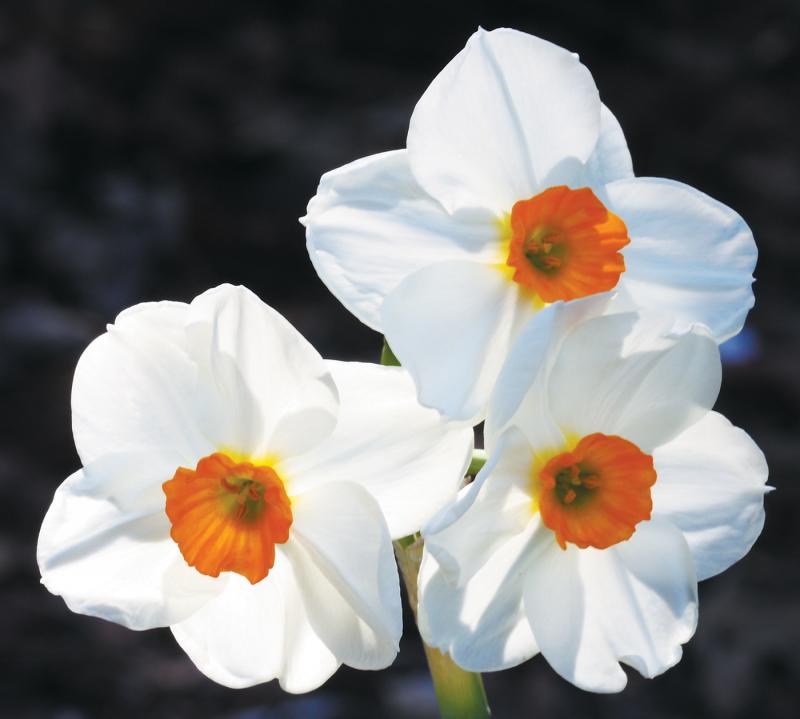When Jack and Jill went up the hill to fetch a pail of water things do not go well for Jack who ultimately breaks his crown, or head. The crown is also known as the corona, as in the sun's crown or corona, a luminous, very hot, highly ionized gas that rings the surface of the sun. Daffodils also have a corona, the ring of outer petals and a trumpet - or cup-shaped center. While the sun has solar flares, some daffodils have an equally fantastic broken or split corona.
These split-corona daffodils have a cup or trumpet that is split, creating an open face on the flower, much like a hibiscus. Split-corona daffodils are probably the most flamboyant and showy of all, and, as such, make for impressive mass plantings and cut flowers.
Try the stunning split-corona daffodil Apricot Whirl with huge 4-inch-wide flowers that are a mix of warm salmon-pink with bright glowing white outer petals. Apricot Swirl is a vigorous midseason bloomer that puts out lots of blossoms. Orangery has tangerine orange split corona against white petals for a bold flower that holds up well in the vase. Papillon Blanc is an all-white exotic split-corona daffodil with wide, creamy white petals set off by a small-ruffled corona that resembles a pom pom. The pastel yellow corona ages into to a creamy white that contrasts with the pure white petals.
Like all daffodils, split-corona daffodils are permanent - plant them and forget them. Many will divide and increase over the years, forming colonies of color. Best of all, they are pretty much deer-resistant.
Split-corona daffodils do best in full sun, though they can handle some shade. Try planting them under deciduous trees that provide dappled light before they fully leaf out.
A good general rule is to plant bulbs three times their height, so a 2-inch high bulb would be planted 6 inches deep. In sandy soils, plant them slightly deeper, in clay or heavy soils plant them a bit more shallow. Split-corona bulbs planted deeper tend not to divide as much into smaller bulbs so can be left in the ground longer without lifting them.
When bulbs are overcrowded they may just send up leaves and stop blooming. For a full bed of bloom, try spacing your bulbs 6 inches apart.
Crushed bone meal is an old-fashioned bulb fertilizer; although, it is often steamed, which destroys many of its nutrients. Instead, look for a good organic bulb fertilizer, or any slow-release balanced fertilizer marked 10-10-10. Just scratch this into the soil surface every fall and again after the daffodils bloom in the spring. Don't over fertilize or you can build up harmful levels of potassium and phosphorus.
Once your split-corona daffodils are done blooming, let all of the leaves die naturally over several weeks.
This is important, because the leaves are gathering nutrients to build up the bulb for the next season's blooms. You can carefully cut or snap off the dead flowers to keep seeds from forming; although, you might want to let them form seeds and self sow.
Usually the leaves will last about six weeks after blooming. Remove the foliage after it has yellowed and died. Resist the urge to tidy up by braiding or tying up the leaves, this will interfere with their health and hurt next year’s flowering.
To cover up the yellow leaves, try planting quick-growing annuals such as corn poppies, forget-me-nots or larkspur. All three of these often self sow, adding to the carefree nature of your daffodil beds. Split-corona daffodils are long-lived and may even increase so much that they become crowded.
Simply dig them up, divide them and replant them right after they bloom. Or you can dig them, divide them and store them in cool, dark place until planting them in the fall.
Plant showy split-corona daffodils this autumn and you will have showy flowers for the garden and for the vase from plants that simply don't fall down on the job.























































